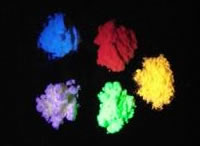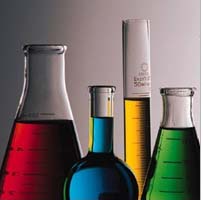Phosphors, Dyes, Pigments and Inks


To jump to the Phosphors, Dyes, Pigments and Inks section of our store, please click here.
Phosphors, Dyes, Pigments and Inks
We have a wide variety of phosphors, dyes, pigments and inks.
Phosphor: A substance that exhibits luminescence including phosphorescent materials and fluorescent materials. A phosphorescent material has a slow decay of brightness with at least a 1 ms decay to materials that can glow for many hours. A fluorescent material will have a rapid decay in brightness once the excitation frequency is removed. Phosphors usually have no solubility. We can make inks using phosphors by making a dispersion or suspension using a water based acrylic clear coat.
Photoluminescent: A substance that glows for a period of time after being charged with light. Most common photoluminescent materials are pigments that can be charged with UV or sunlight and glow for a period of time. Glow period varies with pigment type, color and particle size.
Photochromic: A substance that changes color when exposed to light. Commonly, photochromic pigments react to UV light or sunlight changing color quickly and reverting back after ligt is removed after a minute or so. Photochromic pigments have limited lifetimes as the number of color changing cycles eventually degrades the pigment.
Dyes: Typically thought of as visible colored substances, dyes can also exist in the ultraviolet and infrared light regions. Dyes can refers to solutions, where the material has solubility, and can refer to suspensions where the material is not soluble.
Pigment: A material that changes the color of reflected or transmitted light due to selective wavelength absorption. Pigments can be organic or inorganic and may or may not be soluble.
Ink: A liquid or paste that contains pigments or dyes. Inks can be either solutions or suspensions.
FAQ's on phosphors, dyes and inks.
Phosphors and dyes can be broadly categorized as Organic and Inorganic.
Solubilities: Organic dyes may have particular solubility. For instance, we have an water soluble invisible blue, ethanol soluble invisible blue, acetone soluble invisible red and MEK soluble invisible yellow. If you want to inkjet print, you will probably want a water based or ethanol based ink. While we have made acetone red inkjet cartridges, the volatile acetone solvent evaporates after a week or so. We can make water based and solvent based inks using inorganic phosphors, but these inks are suspensions or dispersions where the phosphors are tiny particles floating in the liquid carrier. Suspensions are not compatible with inkjet cartridges for a number of reasons, but the biggest one is that the particles will clog the jet nozzles. You can print using other methods such as screen printing, pad printing and roll flex, but you will need to work with your printer to figure out how to print exactly. There are many different print methods that require particular viscosity inks, solvent bases, anilox rollers with a certain dot pitch and geometry, etc. While we make a number of different inks, we aren't in a position to formulate an ink for your particular printer.
Light Fastness: A good rule of thumb is that organic materials will fade in sunlight after a week or so. If you print on low acid paper and the paper is kept in the dark, the organic ink can last many years. Inorganic phosphors are often tiny crystalline structures made in high temperature furnaces. The phosphors tend to be very stable, completely insoluble and don't react.
Invisibility: Organic materials tend to be more invisible than inorganic materials. Many inorganic phosphors looks like slightly colored talcum powder. While you can see the inorganic material on something like clear glass, you can apply to paper in a way that makes it invisible. Some organic materials may be water clear, yet you still might see a trace if you apply to a mirror.
Cost: Organic materials tend to cost much less and be brighter. There are some very expensive organic materials, so this is not a hard rule. Many inorganic phosphors are made in high temperature, atmosphere controlled furnaces and tend to be expensive to product.
Fluorescence and Absorption: Security inks tend to have some special property that makes them hard to duplicate or detect. The most common security mark is a longwave UV ink, but that is also the easiest to detect and create. Some of the inks like our IR1 and IR2 inks can't be detected with UV lights, but you need specialized equipment to see the inks. Some of our phosphors and dyes have very particular excitation and emission curves so you need to know exactly how to detect the ink which makes them inherently more secure. Some of the phosphors and dyes we have are very unusual so, even if the person can detect the ink, they can have a very difficult time reproducing the mark.
To jump to the Phosphors, Dyes, Pigments and Inks section of our store, please click here.
Unusual and Useful Specialty Inks, Dyes, Phosphors and Pigments
Some of our products include:
- Invisible Ultraviolet Ink and Pens: Invisible under normal light and visible under ultraviolet (UV) light.
- Invisible Ultraviolet Phosphors and Pigments: Longwave and Shortwave. Organic and Inorganic.
- Invisible Infrared Ink and Pens: Up-Conversion and Down-Conversion
- Phosphorescent Pigments: Long-Life afterglow.
- Refillable Ink Pens with Valve Actions